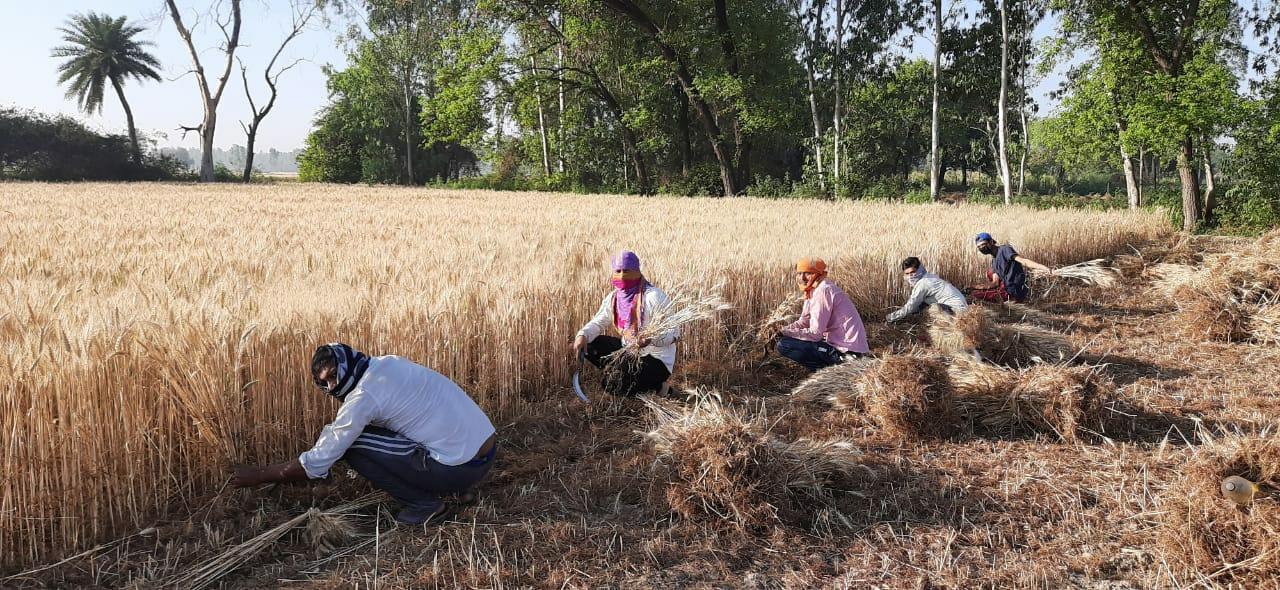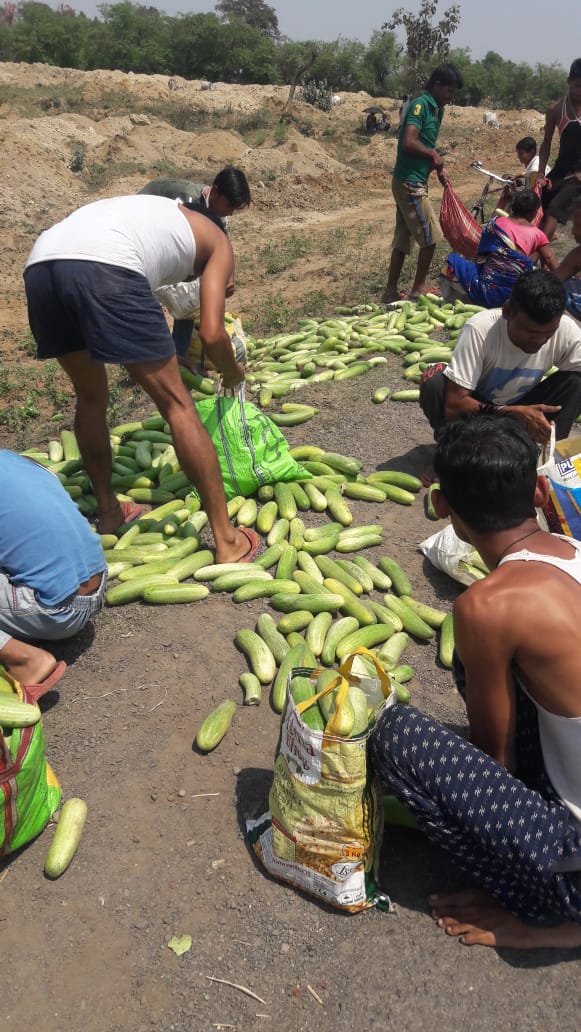
- Home
- News
- Analysis
- States
- Perspective
- Videos
- Education
- Entertainment
- Elections
- World Cup 2023
- Features
- Health
- Business
- Series
- Economy Series
- Earth Day
- Kashmir’s Frozen Turbulence
- India@75
- The legend of Ramjanmabhoomi
- Liberalisation@30
- How to tame a dragon
- Celebrating biodiversity
- Farm Matters
- 50 days of solitude
- Bringing Migrants Home
- Budget 2020
- Jharkhand Votes
- The Federal Investigates
- The Federal Impact
- Vanishing Sand
- Gandhi @ 150
- Andhra Today
- Field report
- Operation Gulmarg
- Pandemic @1 Mn in India
- The Federal Year-End
- The Zero Year
- Premium
- Science
- Brand studio
- Home
- NewsNews
- Analysis
- StatesStates
- PerspectivePerspective
- VideosVideos
- Entertainment
- ElectionsElections
- Sports
- Loading...
Sports - Features
- BusinessBusiness
- Premium
- Loading...
Premium

How the pandemic has hit the hands that feed India
Farmers in many parts of Assam, Bengal and other states too are facing problems in harvesting and transporting their produce due to the COVID-19 lockdown.

A day before Prime Minister Narendra Modi announced the world’s biggest lockdown ever at 8pm on March 24, Kuldip Mishra was on his way to New Delhi’s Lajpat Nagar in a mini truck loaded with medicine boxes. Passing through the expensive condominiums and towering glass office blocks, the 33-year-old driver did not notice anything unusual yet to suggest the nightmare that was to befall him...
A day before Prime Minister Narendra Modi announced the world’s biggest lockdown ever at 8pm on March 24, Kuldip Mishra was on his way to New Delhi’s Lajpat Nagar in a mini truck loaded with medicine boxes.
Passing through the expensive condominiums and towering glass office blocks, the 33-year-old driver did not notice anything unusual yet to suggest the nightmare that was to befall him and many others.
The realisation dawned on him only when he went to park the vehicle after the day’s work. The truck owner bluntly told Kuldip to pack up and return to his village in Uttar Pradesh since there would be no work for days (Delhi CM on March 23 had announced a complete lockdown from March 24-31).
With only ₹1,200 in his pocket, he hurried back to his one-room rented accommodation at Faridabad on the outskirts of Delhi. Faridabad was already under lockdown since March 22 with six other Haryana districts.
Next day in the afternoon, after a filling meal of chapatti and vegetables, he set off for his village in Fatehpur in UP’s Kasganj district, some 212 km away.
“As there won’t be any work in the city for God knows how long, the only option for me was to return home and find some farm work as the harvesting season (of Rabi crops) had started,” Kuldip told The Federal over phone from his village.
With borders sealed and vehicles off the road, Kuldip knew it was a tough choice—either stay back with no work and food or walk his way home. But what he did not expect was to find so many people on the road embarking on a similar homeward journey.
“There were women carrying their children, small girls with paltry belongings perched on the head, boys and girls trailing behind their parents or hitching a ride on their fathers’ shoulders. I also started walking with them. As we crossed village after village, I realised how generous people can be. In many places, several villagers distributed water and food. Some even gave biscuits,” Kuldip recalled.
After walking and hitchhiking for almost two days, Kuldip finally reached his village on March 27 to be quarantined in a village school for 14 days.
There were many others from his village who had undertaken a similar arduous journey. Pawan Kumar (30), a civil engineer, walked around 300 km to reach the village on March 30 from Dausa in Rajasthan where he was working on National Highway 11-A road project. One Mohan Kumar had undertaken over 1,000-km journey on his bike from Rajkot in Gujarat.
Worried over harvest season
“Apart from the uncertain future in the city and the desire to be with the family during this difficult time, another factor that fuelled the desperation was the fear of losing the harvest, the only resources we have now to fall back on,” said Pawan, whose family owns 25 bighas of land. In UP, 6.1772 bighas make one hectare.

Kuldip’s family also owns two bighas of land where they have cultivated wheat. Apart from harvesting their own field, Kuldip and his family also work as farm labourers in the village.
Around 50,000 migrants have come back to the district’s rural areas since the lockdown was announced, said Amit Kumar Tiwari, a local activist-journalist. He said almost all of them work alternatively in farms during the farming season.
“Since most of the people from Kasganj work in Delhi, Gurugram, Noida, Agra, Jaipur and other urban centres not very far from here, they have somehow managed to return home creating a huge pool of farm labourers in this harvesting season,” Tiwari said.
Running of 1,000 buses later arranged by the UP government to ferry migrant labourers who were stranded on the border districts owing to the lockdown also facilitated the homecoming of many.
The sudden surge in labourers bodes good news for relatively big farmers such as Pawan’s family. But for farm labourers such as Kuldip, it means a further blow to their income.
Under normal circumstances, for harvesting standing crop on a bigha of land, a farm labourer in Kasganj area gets 50 kg of wheat instead of cash. One worker, on an average, takes three days to harvest one bigha which yields about four quintals of wheat.
The harvesting span for the Rabi crops is usually 20-25 days. It has been going on in Kasganj and nearby areas for about 10 days now.
Being in quarantine, Kuldip could not take part in the harvesting work in the early days of the season. Moreover, this time the number of competitors has also increased.
“I have already lost my job in the city and in the village too both remuneration and demand for farm work have gone down now. This year, I got contract for harvesting only about three bighas, as against six to seven bighas I harvested in the previous years. Earlier, the wage used to be 45-50 kg of wheat for harvesting one bigha. This time against per bigha I got only 25 kg, and for that too I should consider myself lucky. Many got only 20 kg,” Kuldip said.
“I have heard that the government has announced free rations. But so far, my family at least has not received anything. The only food we got from the government is the allotment against the ration card. Per month per person 9kg of wheat and 6 kg of rice are given for ₹40,” he said.
But even there seems to be some discrepancies, he alleged. “There are seven members in our family. But the ration is allotted only against three members, including my mother who passed away in 2016.”
As the Jan Dhan Yojana bank account was in his deceased mother’s name, Kuldip’s family did not get the benefit of the central government’s claim of distributing ₹7,835 crore into the bank accounts of over 15 crore women – with each account holder getting ₹500.
Since the lockdown, Mishra family has been surviving on chapattis and milk. “We own a cow. She gives two litres of milk daily,” Kuldip said.
The scene in Kasganj and Kuldip’s account are just a subplot in the conflicting stories emerging from rural India’s farm lands.
The area under the Rabi crop cultivation in India is 57.184 million hectares, according to an agriculture ministry data. This is an increase from 53.635 million hectares last year. As was expected, due to favourable weather condition even the output this year is better.
But the lockdown in the wake of Covid-19 epidemic has created a total discord in the farm sector, putting even the Bharatiya Kisan Union, one of the largest associations of the farmers founded by Chaudhary Charan Singh, in a quandary.
“We have to wait and see, how things ultimately pan out across the country. In UP, farmers are harvesting their crops. But in other places the scenario can be different,” said Bhagwan Singh Raghav, organisation secretary of the union’s UP unit.
The other extreme
Far away from Kasganj, migrant workers who have returned to their villages in Tamil Nadu are ready to work as agricultural labourers. But there are few agricultural activities right now and hence they are not getting any work.
“We have more manpower since the migrant workers have returned. Also, the state government has given permission to resume MGNREGA work from April 20. So, even regular farm labourers will divert their energy there” said PR Pandian, general secretary, Tamil Nadu Cauvery Farmers’ Association.
As for Cauvery Delta districts — a major rice cultivation hub (Thanjavur, Tiruvarur and Nagapattinam districts) — the next paddy cultivation starts at June, given water is released from Mettur. Till then, the farmers have no option but to work for MGNREGA. In Tamil Nadu, MGNREGA work started from April 16.
Speaking to The Federal, Gopinath, a senior scientist and economist at MS Swaminathan Research Foundation said MGNREGA work should be extended to agricultural operations.
”At this time of crisis, we should consider small and marginal farmers too, as agricultural labourers,” he said.
More states in a fix
In rural Bengal, where Rabi harvesting season will start in a week or so, many farmers fear that their harvest-ready crops will die on the stalk due to shortage of labourers to harvest the produce.
Uttam Chhatterjee, former panchayat pradhan of Palashdanga village in Bankura district, says shortage of labour is a matter of genuine concern for the farmers this season in many parts of the state.
Mritunjoy Ghosh, a primary teacher of the same village and a farmer agrees with Chatterjee. He has sown paddy on around 60 bighas of land and sesame on eight bighas. Paddy is almost ready for harvesting. “But getting labour to harvest them will be a big issue,” he added.

Chief Minister Mamata Banerjee’s chief advisor on agricultural marketing, Pradip Kumar Majumdar, admits that there could be labour shortage for harvesting in many places due to the restriction on movements of people. To tide over the problem, he said the government has decided to provide combine harvesters (a harvesting machine) wherever there is a labour shortage. There are about 3,000 such machines in the state. These machines need three persons to operate and takes just one hour to harvest one bigha of land. It needs four persons to harvest the same area manually.
One machine can be hired for ₹800 per hour. “The per day wage of a farm labourer is ₹200-220,” Ghosh said. So, money is not an issue in engaging the machine. “Our only problem is that most of the operators who know how to run these machines come from Punjab every year,” Ghosh pointed out, adding he had utilised the service of the machine last year. “The operators had come from Punjab. I am not sure they will be able to come this year,” he said.
Veggie growers’ nightmare
The farmers’ woes don’t end here. In many cases, they were forced to leave fruits and vegetables unplucked because of shortage of labourers.
Those who were able to cultivate fruits and vegetables with the help of their family members are now facing transportation problems. Even though the government has given certain relaxation in the movement of farm produce, there seems to be some communication gap.
“Even if the goods reach market, the takers are very few. Since most of them are small and marginal farmers they lack the storage facility too. Hence, the farmers let the produce perish,” said Dhanapal, president, Federation of Tamil Nadu Farmers’ Associations.
Farmers in Bihar’s Nalanda on April 13 staged a protest accusing policemen of imposing a penalty while they were taking vegetables to market in their vehicles.
The policemen misbehaved, asked for license and other papers and lathi-charged, the protesting farmers alleged. Vegetable growers in many parts of Assam, Bengal and other states too are facing similar problems, forcing them to dump their produce on roads.
Amid all this, what was scarier, Kuldip said, was the uncertainty. “Kisi ko pata nahi ye kab khatam hoga (No one knows when life will be normal again).”
However, one thing that Kuldip knows for certain is that he will sort out his wedding plans. “Meri shaadi rukh gayi iss Covid ki wajah se (My wedding has been postponed due to the Covid-19 crisis),” he sighs.

